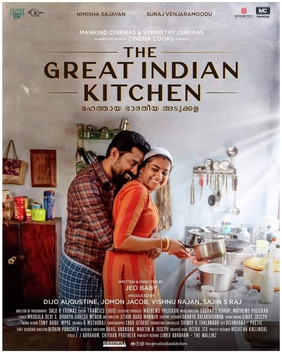The Great Indian Kitchen

The movie received critical acclaim and was remade in Tamil with a Hindi remake in the works. Licensed as a promotional poster.
The expectation of newlywed women in many cultures can be considered incredibly misogynistic. You must operate with obedience, cooking three different dishes three times a day, cleaning, and dealing with disrespect from the man you married. Hence, an Indian woman is essentially considered a “great Indian kitchen.” The perspective of newlywed women can be understood, but it has never been captured in its infamy quite like the way Jeo Baby writes it in “The Great Indian Kitchen.”
The main characters in the film have no names. They are simply known as Wife and Husband. These unconventional character names emphasize the most prominent theme in the movie: gender roles. Wife is a newlywed woman who needed to be made aware of the job description of being a traditional housewife. After the marriage, she moves into her husband’s family’s house and is expected to undertake all the household responsibilities, such as cooking, cleaning, and caring for her in-laws. Her husband initially does support her modern outlook but soon realizes that her new family’s traditional beliefs and social roles will not align with her contemporary views.
The film’s significance stems from examining gender inequality and the load of home work that women are often expected to carry. The daily hardships faced by millions of women in patriarchal societies like India and other parts of the world are shown through the experiences of Woman, a character that can easily be molded into many real-life women. The film also delves into the idea of being the most perfect, ideal man in a 4×4 room but leaving that attitude behind as soon as he steps out. This reflects the way people with intense spirituality often represent themselves in front of an idol or a room dedicated to their religion but lose that appearance as soon as they step out of that room. Baby encourages viewers to reflect on cultural norms and domestic work by realistically presenting the problem.
The film’s director, Jeo Baby, also wrote the script. His writing is often insightful and tender, carefully representing a detailed account of the protagonist’s difficulties and feelings. In addition to the astute script, the stunning cinematography is another impressive aspect of the film. Salu K Thomas’ stunning cinematography perfectly captures the scenery that is Kerala’s lush countryside and the minute details of a family’s daily routines.
Nimisha Sajayan leads the cast with a strong and nuanced performance as the wife of Suraj Venjaramoodu’s character. As the husband, he delivers the perfect amount of subtle intensity that emphasizes his character’s confused emotions about providing his wife with comfort. The supporting actors that build up the film’s community play a big role in bringing the world of the movie to life, as marriages in more rural parts of the world are usually concerned with the entirety of the village community.
While the film’s ideas are central to Indian society, the film still is a window into the lives of women living in heavily patriarchal societies worldwide who suffer the burden of gender inequality and enforced domestic labor. This message is applicable and valuable to anyone, regardless of their background. “The Great Indian Kitchen” is a must-watch movie that provides a powerful insight into the weight of domestic labor in India, but that should also be explored by larger audiences who can appreciate the strong performances of these up-and-coming actors that deserve more credit than they are given.

Saisree is a senior who enjoys interviewing and featuring people at any chance. Since the age of 10, when she wrote an article about Will Smith using a discussion that had never happened, she knew she eventually wanted to interview people. Apart from Newspaper, Saisree enjoys taking contesting courses that she prays she will do well in just for a challenge. She is particularly interested in biotechnology and how it will either benefit or end the human race. She is an artistic person, very much in tune with her culture, and does Indian classical dance, violin, and vocals. To power the force Saisree attempts to be, she relies solely on purple grapes because they are higher in antioxidants and protect...





